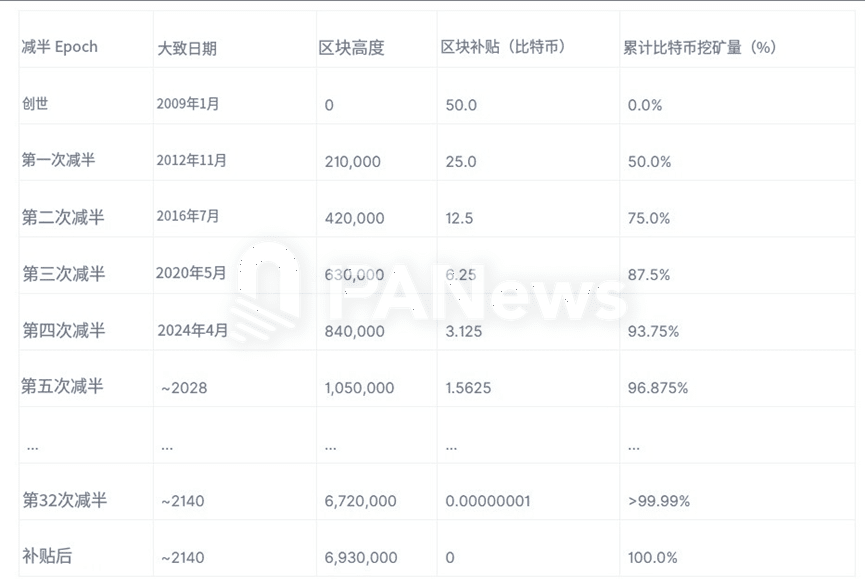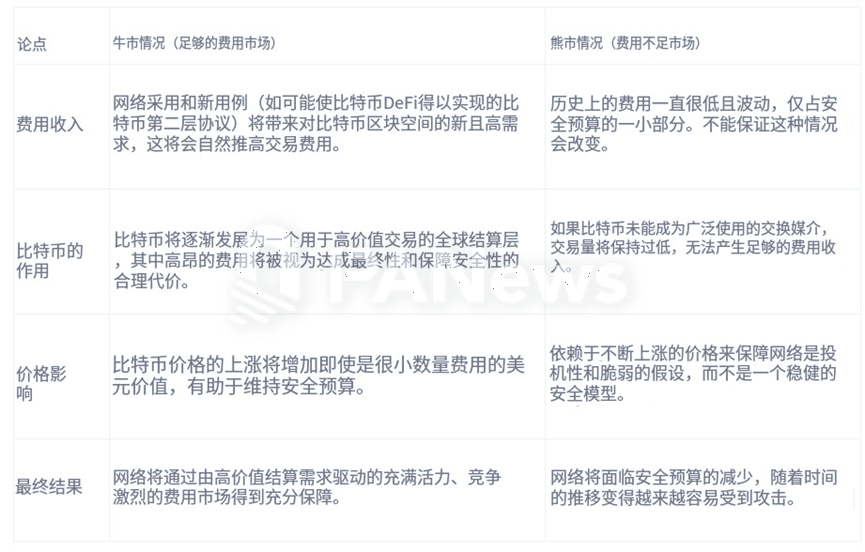Author: Coingecko
Compiled by: Felix, PANews
Around 2140, there will no longer be new Bitcoins issued in the market. All 21 million Bitcoins will have been distributed, meaning that Bitcoin miners will only receive rewards in the form of transaction fees. Critics argue that relying solely on transaction fees is insufficient to maintain the security of the Bitcoin network.
Key Points
After 2140, the block subsidy will cease to exist. Bitcoin miners are crucial for processing transactions and securing the network, and they will then only be compensated through transaction fees paid by users.
The gradual reduction of mining fees raises questions about Bitcoin's long-term security, as mining fees serve as Bitcoin's 'security budget'.
A reduction in the security budget may expose the Bitcoin network to the risk of 51% attacks and/or lead to increased centralization of the network.
Bulls believe that the rising value of Bitcoin assets and the increasing demand for blocks will make a market reliant solely on transaction fees economically viable for Bitcoin miners.
The most renowned characteristic of Bitcoin is its scarcity, earning it the title of 'digital gold'. To ensure scarcity, the rewards paid to Bitcoin miners are gradually reduced every four years through 'Bitcoin Halving'. However, this mechanism presents a significant long-term challenge.
The primary incentive for miners in the Bitcoin network — the rewards of newly generated Bitcoins, known as block subsidies, will completely disappear around 2140 through the aforementioned Bitcoin halving mechanism. Block subsidies essentially serve as Bitcoin's security budget, paid to miners to ensure the security of the Bitcoin network. This raises a question:
Are the remaining transaction fee incentives sufficient to secure the network?
Understanding Bitcoin's Incentive Model
To understand the challenges of the post-subsidy era, it is necessary to examine the current incentive mechanisms that secure the Bitcoin network. Every ten minutes, a miner validates a new transaction block and receives a block reward, which consists of two parts.
Block Subsidy: This is the predetermined amount of newly created Bitcoin. When Bitcoin was first launched, the subsidy for each block was 50 Bitcoins. This amount is halved every four years, an event known as 'Bitcoin Halving'. This mechanism distributes 21 million Bitcoins over decades and is the primary source of miners' income to date.
Transaction Fees: This is the fee that users include in transactions to incentivize miners to add them to blocks. You can think of it as an additional 'tip' paid to Bitcoin miners to help users ensure their transactions are completed smoothly, creating a competitive market environment. As of the time of writing, the average transaction fee for Bitcoin is $1.30 per transaction.
Bitcoin Halving: Reducing the Issuance Rate
Each Bitcoin halving is a cyclical efficiency test for the mining industry, as each halving effectively halves miners' income. This ensures that only the most efficient miners can profit, while less efficient miners may shut down, but a potential negative effect is that this may temporarily lead to a decline in the overall network hash rate.
The Bitcoin network's hash rate is the total computational power used to secure the Bitcoin network, and it decreases when Bitcoin miners shut down. A reduction in network hash rate means the Bitcoin network is more susceptible to network attacks such as a 51% attack (where a single entity controls enough hash power to disrupt the blockchain).

Table 1: Predictable Decline of Bitcoin Block Subsidy Over Time
Bitcoin Block Reward in 2025
To further illustrate the importance of Bitcoin block subsidies to miners, here are the details of the rewards for successfully mining a Bitcoin block.
According to blockchain transaction fee data, in July 2025, each new Bitcoin block contains approximately 0.025 Bitcoin in transaction fees. As of April 2024, the block subsidy is 3.125 Bitcoins.
In summary, the 'salary' for Bitcoin miners who mine a block:
Guaranteed Reward (Newly Generated Bitcoin): 3.125 Bitcoins
Additional 'tips' (from transaction fees): approximately 0.025 Bitcoin
Total income per block: approximately 3.15 Bitcoins.
The 'tips' in transaction fees only account for a very small portion of miners' total income, which means that miners are almost certainly unable to profit in a market that relies solely on transaction fees.
Discussion on the Economic Viability of Bitcoin in the Post-Subsidy Era
Relying solely on Bitcoin transaction fees is insufficient to secure the Bitcoin network in the current market. However, bulls believe that by 2140, demand will drive transaction fees to levels far above current levels, while bears foresee a crisis. Below, we will explore the main arguments for each viewpoint.

Table 2: Summary of Arguments from Various Parties
Pessimistic Argument: Reduction of Security Budget
The basis for the pessimistic view is simple: historical trends in transaction fees have not shown an increase sufficient to offset the reduction in subsidies. Critics are concerned that each halving will cut the security budget, gradually lowering the network's security.
Optimistic Argument: Strong Fee Market
Optimists believe that Bitcoin will be supported by its continually rising asset value and growing block demand. Firstly, with the help of Bitcoin's deflationary design, the network will evolve into an asset class worth trillions of dollars, meaning that even a small percentage of Bitcoin transaction fees will bring substantial income to miners in the future.
Secondly, there will be a fundamental increase in demand for block space itself, which may manifest in the form of large institutional settlements, layer 2 scaling solutions (Layer 2 rollups), or some yet-to-be-discovered new innovations. Ultimately, these factors will drive up transaction fees, making them economically viable in the future.
Potential risks of reduced security budget
A decline in the security budget may lead to a large number of Bitcoin miners shutting down, reducing the total hash rate of the Bitcoin network, which could trigger a series of potential risks and put pressure on the integrity of the network.
51% Attack
The most concerning threat is a 51% attack, where an entity controlling more than half of the network's hash power can reverse transactions (double spending) or censor the network. The security budget is a major line of defense; the higher the budget, the more hash power can be supported, and the higher the cost of attacks. Nowadays, for rational economic actors, the cost of launching such an attack is prohibitively high, as it would likely lead to a crash in Bitcoin prices, thereby reducing the value of the attacker's own hardware. However, for geopolitical reasons, state-level actors may be willing to absorb such losses to undermine the network. As the security budget decreases, the cost of attacks lowers, and the likelihood of such threats increases in the long term.
Hash Rate Fluctuation
A more direct risk is miners capitulating, meaning that the reduction in earnings due to Bitcoin halving forces a large number of miners to shut down their machines, resulting in a sharp decline in hash rate. Although difficulty adjustments will correct this, the rapid exit of miners may create a fragile window period in the short term.
Bitcoin Innovation as a Solution
The Bitcoin community is actively developing solutions to promote network adoption and mitigate the risks associated with the gradual reduction of Bitcoin's security budget. Here are some of those solutions.
Layer 2 Solutions
One solution to the limited on-chain capacity of Bitcoin is L2 blockchain. L2 is a sub-blockchain built within the main blockchain (referring to Bitcoin here), transferring transactions from the main blockchain to these L2s to increase transaction speed and reduce costs.
L2 solutions like the Lightning Network enable Bitcoin to be used for everyday transactions, which has already seen some degree of adoption in Vietnam. The Bitcoin community in Vietnam, 'Bitcoin Saigon', often collaborates with local merchants, cafes, and markets to promote and support the use of Bitcoin payments powered by the Lightning Network. If L2 solutions succeed, it will push the Bitcoin network from specialized applications to everyday applications, thereby increasing transaction fees on the main Bitcoin blockchain network.
Bitcoin Runes
The runes that gained popularity in 2024 are a token standard that utilizes Bitcoin's UTXO model (where wallet balances are composed of unspent Bitcoins from individual blocks, similar to coins and banknotes in a wallet) and the OP_RETURN opcode (which allows for the embedding of a small amount of data in Bitcoin transactions, akin to the memo field on a check). Runes made it possible to create meme coins and community tokens on the Bitcoin blockchain. At its peak, runes pushed the average transaction fee for Bitcoin to a historic high of $127 per transaction. Although market interest in runes has waned, this innovation showcases new use cases that could potentially drive up Bitcoin's transaction fees, paving the way for a Bitcoin economy solely reliant on fees in the future.
Future User Experience
For ordinary users, interactions with Bitcoin may be a multi-layered experience. Sending transactions directly on the first layer is expected to become expensive, only for large transfers. For everyday transactions, users will almost certainly interact with Bitcoin through L2 solutions like the Lightning Network, which can provide instant and low-cost experiences, or by using Wrapped Bitcoin. This shift means that the user experience for small payments will still be viable but will be realized at a different technological level than the main blockchain.
Long-term outlook for investors
For investors, the end of block subsidies creates a critical conflict between Bitcoin's two core attributes (scarcity and security). Investors are attracted to Bitcoin's fixed supply, but they now face the reality that the network's security is dynamic and will depend on future fee markets. If the network supporting the scarce asset is perceived to have vulnerabilities, its long-term value becomes questionable. Ultimately, Bitcoin's value derives not only from its technical characteristics but also from the collective confidence of the market in its ability to remain secure.
Conclusion
The day the last new Bitcoin is mined does not signify the end of Bitcoin, but rather the beginning of its ultimate test. The end of block subsidies is the expected final state of the protocol, with the ecosystem having over a century to adapt to this challenge. The long-term security of Bitcoin will be determined by a complex interplay of various forces: technological innovations in L2 solutions, economic evolution of the fee market, and social consensus around Bitcoin as a global settlement layer.
Note that this article discusses concerns that may exist in the distant future of Bitcoin, and given the century-long gap from now until 2140, its content is highly speculative.
Related Reading: One Year After Bitcoin Halving: Why This Cycle Looks Very Different?

